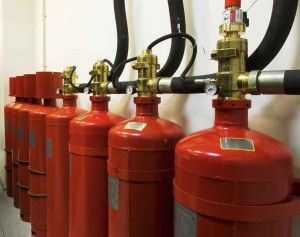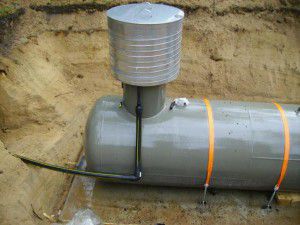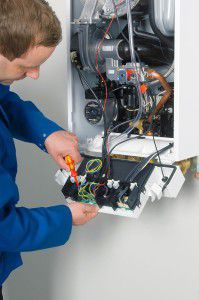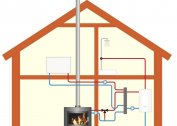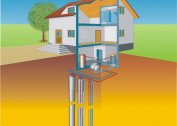Propane-butane-filled gas cylinders have long been familiar in the kitchens of country houses. But will it be a rational decision to arrange heating of a private house on liquefied gas? Before converting a home heating system to the consumption of liquefied petroleum gas (LPG), you need to clarify a few issues for yourself. Among them, the most important - what will be the consumption of liquefied gas for heating a house, and how real will the benefit be?
Gas heating from cylinders
Often there are reviews that heating with liquefied gas allegedly requires huge cash costs. It was believed that the purchase of gas equipment, as well as installation and maintenance of the system, was accompanied by excessive costs. But this is not always true, and year after year the heating of a private house with liquefied gas in cylinders is gaining new adherents among the owners of cottages and cottages.
Advantages of LPG
- An opportunity to arrange autonomous heating on the liquefied gas in a distance from gas pipelines;
- Convenience of transportation that does not require the construction of pipelines;
- Higher heat capacity of the propane-butane mixture compared to natural gas;
- Ecological purity of fuel obtained during oil production and refining;
- Relatively low cost in terms of the rise in price of other types of fuel.
Disadvantages of LPG
- The cost of delivering gas for heating private houses with liquefied gas in cylinders can increase when the home ownership is located too far from the city;
- In the frosty winter, when a private house is heated with liquefied gas, there is a problem of freezing of the gas reducer;
- If you create a supply of fuel in a gas tank installed on your site, then during periods of snow drifts there are difficulties with getting to the tanker’s house;
- Designing and installing autonomous heating using liquefied gas is allowed only with the assistance of specialists from authorized organizations. And only the least critical elements of a heating system for liquefied gas are permissible to make with your own hands.
Features of heating with liquefied gas
The owner of the liquefied gas heating system is forced to monitor whether the fuel is running out in the tank connected to the boiler. Some will find this feature inconvenient, but such a heating system can be autonomous and not depend on problems with the central gas supply. It is only necessary to regularly replace gas cylinders or immediately pump enough gas into the underground storage.
The use of gas cylinders in heating
The option of heating a house with liquefied gas in 50-liter cylinders is the best suited for country houses and small cottages. In order not to have to disconnect an empty cylinder every two days and connect a full one in its place, you can combine several cylinders into a battery at once. To do this, use the GOK fittings. If the homeowner installs heating on liquefied gas with his own hands, he has the right to install a battery of no more than 3 cylinders without a project. A larger number will require a project.
They install gas cylinders not in the room, but in a metal cabinet from the outside of the house.In winter, there are frequent cases of a decrease in the gas supply through the gearbox due to the fact that the condensate contained in the cylinders partially freezes.
To prevent freezing of the gears at low temperatures, a small electric heater can be installed in the cabinet with cylinders.
Gas holder for home heating
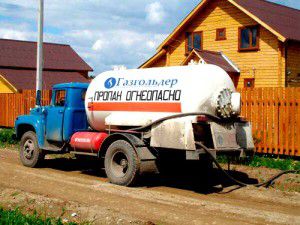
It is convenient to use cylinders when the gas flow is not too large, and their delivery service is uninterrupted. In other cases, it will be more rational to purchase and install a gas holder - a large underground storage tank for LPG, which will have to be refueled with gas only 2-3 times a year. The volume of the gas tank can be from 3 to 10 cubic meters, it is chosen in accordance with the capacity of the heating system.
The underground gas tank is allowed to be placed no closer than 10 m from the apartment building, and from the side of the road there must be access to it for accessing the refueling vehicle.
Calculation of costs for an autonomous gas heating device
Comparing which of the varieties of heating systems will be the least costly, you must first pay attention to the consumption of liquefied gas for heating. It is advisable to compare future costs with similar costs for other fuels and decide which option will be more profitable.
Initial costs for equipment and arrangement
The costs of acquiring equipment and installing an autonomous liquefied gas heating system in your home may vary slightly in different regions of residence. But in general, when compared with the connection to the main gas pipeline, the difference in cost will be insignificant. It will be more expensive only if you use not cylinders, but a gas tank with a volume of several cubes. Its cost will be more than 300,000 rubles.
The construction of premises for boilers using LPG is also almost equivalent in cost compared to those that work on diesel fuel. According to reviews, heating with liquefied gas only requires higher initial costs when it serves as an alternative to solid fuel or electric heating. But in the course of further operation, the funds invested in heating a private house with liquefied gas will gradually pay off due to the profitability of this type of fuel.
Gas consumption but heating a private house
A few years ago, the propane-butane mixture was much more expensive than main gas (methane), but over time the price difference between them decreases. Therefore, relative indicators of the cost and consumption of liquefied gas for heating demonstrate the feasibility of using this energy source.
| Type of fuel | Specific calorific value, mJ | Retail cost of fuel, rubles | The cost of kW / h of energy, rubles. |
| Propane-butane mixture (LPG) | 45–47 | 20-24 (per 1 kg) | 1,7–2,0 |
| Natural gas | 32–40 | 5.2–5.6 (for 1 m³) | 0,6–0,9 |
| Diesel fuel | 40–42 | 23–27 (per 1 liter) | 2,6–2,8 |
| Electric power | — | — | 3,5–3,8 |
The easiest way to determine the actual consumption of liquefied gas for heating a house would be to correlate the mass of gas in one bottle with the technological characteristics of the heating equipment. In this case, it is more convenient to calculate the flow rate precisely by weight, since the volume (in liters) depends on the density and percentage composition of the propane-butane mixture pumped into the cylinder.
A standard 50-liter cylinder can be filled with 35–40 liters of LPG, which in terms of weight gives an average of 22 kg of gas.
We will analyze a specific example for determining the required amount of liquefied gas in cylinders for heating a house with an area of 100 m²:
- For heating the specified area you will need (at maximum standards) 10 kW of heat;
- However, the boiler does not operate continuously in the maximum mode, and the average load factor can be taken as 0.5. So we need 5 kW;
- With a calorific value of liquefied gas of 46 mJ / kg for the production of 1 kW of heat energy, about 0.1 kg of LPG per hour will be consumed, and for 5 kW 0.5 kg of LPG will be required;
- 12 kg, or almost half of the cylinder, will be consumed per day;
- The monthly consumption of liquefied gas for continuous heating of the house will be approximately 13-15 cylinders.
What will be the consumption if using not cylinders but pumping fuel into a gas tank? How often do you have to call a gas tanker to replenish the gas supply in the most common “five-cube” tank among consumers? Let's figure it out:
- Any of the tanks for liquefied gas is filled not “under the neck”, but only by 80–85%. Accordingly, in a tank with a volume of 5 m³ there will be about 4250 liters or (in terms of weight) 2300 kg of gas;
- We have already determined that in our case, a liquefied gas heating system consumes 0.5 kg of fuel per hour;
- We divide the total mass of gas contained in the gas tank 2300 kg by 0.5 kg / hour, and get 4600 hours - for such a time we have enough fuel;
- Dividing 4600 hours by 24, we get a total of 190 days. That is, one gas tank refueling with a volume of 5 m³ is enough to heat a house of 100 m² for almost the entire heating season (in a temperate climate).
These are theoretical calculations, but in reality fuel consumption can be significantly reduced. With the correct setting of the combustion modes, the gas heating boiler for liquefied gas is able to consume 1.5–2 times less fuel, and the temperature in the house will be maintained at an acceptable level.
To reduce the amount of combustible gas, use automation, which at night puts the boiler in moderate mode, reducing the temperature in the system by 7–9 degrees, thereby achieving cost savings of 30%.
Heating equipment for heating with liquefied gas
For heating a private house on liquefied gas, both heating boilers with a water circuit and gas convectors are used. But among all types of such equipment, liquid fuel heating boilers are still leading, as the most productive. Reviews of heating with liquefied gas using convectors are rarely positive.
The gas heating boilers for liquefied gas in their design are almost no different from those that consume main gas. The difference is only in the arrangement of the burners, since the pressure of the propane-butane coming from the cylinder is almost 2 times higher than that of natural methane. Accordingly, the nozzles in the burners also differ in internal diameter. Some differences are also in the devices for adjusting the air supply.
The gas heating boilers for liquefied gas in their design are almost no different from those that consume main gas. The difference is only in the arrangement of the burners, since the pressure of the propane-butane coming from the cylinder is almost 2 times higher than that of natural methane. Accordingly, the nozzles in the burners also differ in internal diameter. Some differences are also in the devices for adjusting the air supply.
The design differences are so insignificant that, if necessary, it is enough to just replace the burners in a boiler designed for methane, and you will not have to buy a new heating boiler using liquefied gas.
Consider the difference between the main models of boilers for a heating system on liquefied gas:
- Boiler type. Among units for heating a private house with liquefied gas in cylinders, single-circuit and double-circuit boilers are distinguished. The first serve only for the heating system, and the second, in addition, provide hot water. The combustion chamber in boilers is arranged differently, it can be open or closed.Both large floor models and compact wall are produced;
- Efficiency. Judging by the reviews, heating with liquefied gas can become truly rational and economical if the gas boiler has an efficiency of at least 90-94%;
- Boiler power. It is considered one of the main parameters when heating a private house with liquefied gas. It is necessary to make sure that the passport characteristics of the unit will allow it to develop sufficient power to provide the entire area of the house with heat, but at the same time avoiding excessive consumption of liquefied gas for heating;
- Manufacturer. While the piping in the heating system using liquefied gas can be done with one's own hands, a gas boiler should by no means be home-made. Moreover, it is desirable to give preference to well-established domestic or foreign manufacturers.
It is forbidden to install liquefied gas boilers in the basement, since the propane-butane mixture is heavier than air. Such gas does not erode during leakage, but accumulates at floor level, which can lead to an explosion.
Gas heating system maintenance
The heating system of a private house using liquefied gas requires periodic monitoring and maintenance. The trouble is, if in the middle of winter the boiler suddenly ceases to function normally! Causes of malfunctions of gas heating boilers for liquefied gas
mainly associated with clogged burner or fuel filter. It is desirable to detect all malfunctions in advance, and an experienced specialist should be engaged in their search.
The technician should check the condition of the liquefied gas heating boiler 1-2 times a year and carry out maintenance with the same regularity. The list of works is reduced to inspection of burners and a combustion chamber, cleaning of soot and soot, checking automation, adjusting equipment.
It is not recommended that you clean the burner yourself with a metal brush or clean the nozzle hole with a wire, as this will interfere with its calibration.
The video demonstrates what a worthy alternative to natural gas can become liquefied petroleum gas (LPG).
In conclusion, we can add that many users campaign for heating with liquefied gas, their reviews indicate the effectiveness of the autonomous system. Even despite the troubles associated with the periodic replacement of gas cylinders.

